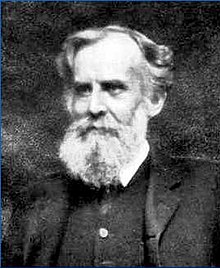John Venn
| John Venn | |
|---|---|
 |
|
| Born |
4 August 1834 Kingston upon Hull, Yorkshire, England |
| Died | 4 April 1923 (aged 88) Cambridge, England |
| Nationality | English |
| Fields |
Mathematics Logic Philosophy |
| Institutions | University of Cambridge |
| Alma mater | University of Cambridge |
| Notable awards | Fellow of the Royal Society |
| Signature | |
John Venn, FRS,FSA, (4 August 1834 – 4 April 1923) was an English logician and philosopher noted for introducing the Venn diagram, used in the fields of set theory, probability, logic, statistics, and computer science.
John Venn was born on 4 August 1834 in Kingston upon Hull, Yorkshire to Martha Sykes and Rev. Henry Venn, who was the rector of the parish of Drypool. His mother died when he was three years old. Venn was descended from a long line of church evangelicals, including his grandfather John Venn.Venn was brought up in a very strict atmosphere at home. His father Henry had played a significant part in the Evangelical movement and he was also the secretary of the ‘Society for Missions to Africa and the East’. Establishing eight bishoprics overseas. His grandfather was pastor to William Wilberforce of the abolitionist movement, in Clapham.
He began his education in London joining Sir Roger Cholmeley's School, now known as Highgate School, with his brother Henry in September 1846. He moved on to Islington proprietary school and in October 1853 he went to Gonville and Caius College, Cambridge. In 1857, he obtained his degree in mathematics and became a fellow. In 1903 he was elected President of the College, a post he held until his death. He would follow his family vocation and become an Anglican priest, ordained in 1859, serving first at the church in Cheshunt, Hertfordshire, and later in Mortlake, Surrey.
...
Wikipedia
